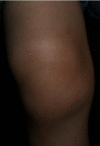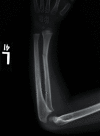Lyme Disease Misinterpreted as Child Abuse
- PMID: 33628554
- PMCID: PMC7880705
- DOI: 10.1155/2021/6665935
Lyme Disease Misinterpreted as Child Abuse
Abstract
Child abuse is one of the most common causes for child fatality in the United States. Inaccurate reporting of child abuse combined with scarcity of resources for child abuse evaluations can lead to unintended consequences for children and their families. The differential diagnosis of child abuse is varied. To our knowledge, there are no reports in the literature on Lyme disease mimicking child abuse. The current study presents the case of a child from an endemic area for Lyme disease presenting with skin bruising, fracture, and swollen knee. The child was reported for child abuse by the pediatrician and then referred to the orthopaedic surgeon for fracture care.
Copyright © 2021 Tommy Pan et al.
Conflict of interest statement
The authors declare that they have no conflicts of interest.
Figures




Similar articles
-
Systematic reviews of bruising in relation to child abuse-what have we learnt: an overview of review updates.Evid Based Child Health. 2013 Mar 7;8(2):255-63. doi: 10.1002/ebch.1909. Evid Based Child Health. 2013. PMID: 23877882 Review.
-
Orthopaedic aspects of child abuse.Instr Course Lect. 2013;62:399-403. Instr Course Lect. 2013. PMID: 23395044
-
Children with anogenital symptoms and signs referred for sexual abuse evaluations.Arch Pediatr Adolesc Med. 1998 Jul;152(7):634-41. doi: 10.1001/archpedi.152.7.634. Arch Pediatr Adolesc Med. 1998. PMID: 9667533
-
Lyme disease presenting as popliteal cyst in children.J Pediatr Orthop. 2006 Nov-Dec;26(6):725-7. doi: 10.1097/01.bpo.0000242430.91489.fd. J Pediatr Orthop. 2006. PMID: 17065933
-
Lyme disease in children.Am J Med. 1995 Apr 24;98(4A):69S-73S. doi: 10.1016/s0002-9343(99)80047-3. Am J Med. 1995. PMID: 7726195 Review.
Cited by
-
A Multispecialty Approach to the Identification and Diagnosis of Nonaccidental Trauma in Children.Cureus. 2022 Jul 26;14(7):e27276. doi: 10.7759/cureus.27276. eCollection 2022 Jul. Cureus. 2022. PMID: 36039273 Free PMC article. Review.
References
Publication types
LinkOut - more resources
Full Text Sources
Other Literature Sources

